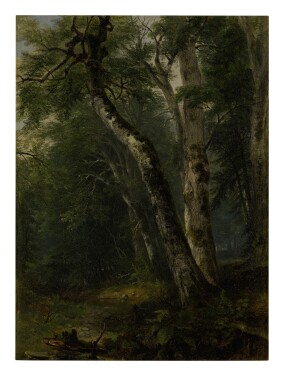Works by Asher Brown Durand at Sotheby's
Asher Brown Durand Biography
Asher Brown Durand was an important member of the Hudson River School, a fraternity of American landscape painters initially led by Thomas Cole, who served as Durand’s instructor in the 1840s. Durand’s naturalistic paintings brilliantly capture the fresh, untamed beauty of the American wilderness.
Durand was born in Jefferson Village (now called Maplewood), New Jersey in 1796; his father was a watchmaker and silversmith. After serving as an apprentice to his father, Durand was apprenticed to the engraver Peter Maverick from 1812 to 1817; in 1818, Durand became Maverick’s associate and opened a branch of the firm in New York City. In 1820, Durand engraved artist John Trumbull’s famous painting, The Declaration of Independence. While the commission fractured Maverick and Durand’s relationship, it served to elevate Durand’s reputation within New York’s artist community. Subsequently, Durand joined a number of prominent clubs and organizations in the city and became a founding member of the National Academy of Design.
Around 1830, Durand’s focus began to shift from engraving to painting. The change was influenced by fellow artists, including Hudson River School founder Thomas Cole, who encouraged Durand to accompany him on his exhibitions in the Adirondacks and New Hampshire’s White Mountains. Luman Reed, a wealthy business owner and Durand’s patron, also encouraged this shift in focus.
As Durand and Cole’s friendship grew, so did the former’s commitment to landscape painting. In 1840, Durand embarked on a year-long trip to Europe; he was joined on the journey by the young painters John Frederick Kensett and John William Casilear. For Durand, the most significant moment of the trip came in London, when he had the opportunity to explore John Constable’s estate. The simple naturalism of Constable’s paintings struck Durand as highly important, and the artist would continue to be influenced by the hand of the late British master.
Upon Cole’s death in 1848, Durand became the guiding force for the second generation of Hudson River School painters. In the summer, young painters would flock to Durand’s studio in the White Mountains to study under his guidance. In 1855, Durand became the president of the National Academy of Design; he held this post for a decade, until the onset of the Civil War.
In his later decades, Durand retreated from the Hudson River School style, instead painting in the more conventional landscape style seen in the 18th and 17th century. By 1869, Durand formally retired from painting and returned to Maplewood, New Jersey. Durand died in 1886, at age 90.
Today, a number of museums hold works by Durand in permanent collections, including the National Gallery of Art, Washington D.C., the Metropolitan Museum of Art, New York and the Smithsonian American Art Museum, Washington, D.C., among others.







